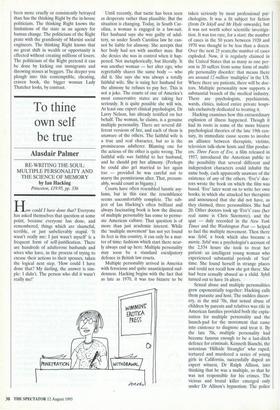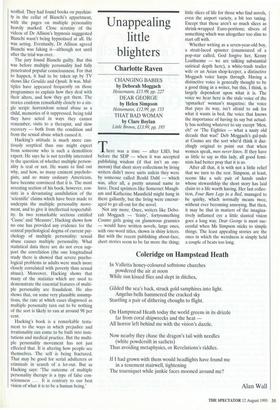To thine own self be true
Alasdair Palmer
RE-WRITING THE SOUL: MULTIPLE PERSONALITY AND THE SCIENCE OF MEMORY by Ian Hacking Princeton, £19.95, pp. 336 How could I have done that? Everyone has asked themselves that question at some point, because everyone has done, and remembered, things which are shameful, terrible, or just unbelievably stupid. 'It wasn't really me: I just wasn't myself' is a frequent form of self-justification. There are hundreds of adulterous husbands and wives who have, in the process of trying to excuse their actions to their spouses, taken the logical next step. 'How could I have done that? My darling, the answer is sim- ple: I didn't. The person who did it wasn't really me!' Until recently, that tactic has been seen as desperate rather than plausible. But the situation is changing. Today, in South Car- olina, a woman is engaged in a law-suit. Her husband says she was guilty of adul- tery, so under South Carolina law he can- not be liable for alimony. She accepts that her body had sex with another man. But she denies she was in control when it hap- pened. Not metaphorically, but literally. It was another woman — her alter ego, who regrettably shares the same body — who did it. She says she was always a totally faithful wife. She is suing her husband for the alimony he refuses to pay her. This is not a joke. The courts of one of America's most conservative states are taking her seriously. It is quite possible she will win. At least one expert clinical psychologist, Dr Larry Nelson, has already testified on her behalf. The woman, he claims, is a genuine multiple personality. There are several dif- ferent versions of her, and each of them is unaware of the others. The faithful wife is a true and real character, but so is the promiscuous adulterer. Blaming one for the actions of the other is quite wrong. The faithful wife was faithful to her husband, and he should pay her alimony. (Perhaps he could also get married to her again too — provided he was careful not to marry the promiscuous alter. That, presum- ably, would count as bigamy.) Courts have often resembled lunatic asy- lums, but in this case the resemblance seems uncomfortably complete. The sub- ject of Ian Hacking's often brilliant and always fascinating book is how the disease of multiple personality has come to perme- ate American culture. That question is of more than just academic interest. While the 'multiple movement' has not yet found its feet in this country, it can only be a mat- ter of time: fashions which start there near- ly always end up here. Multiple personality may soon be a standard exculpatory defence in British law courts.
Multiple personality arrived in America with ferocious and quite unanticipated sud- denness. Hacking begins with the fact that as late as 1970, it was too bizarre to be taken seriously by most professional psy- chologists. It was a fit subject for fiction (from Dr Jekyll and Mr Hyde onwards), but it was not worth sober scientific investiga- tion. It was too rare, for a start: the number of cases in the 50 years between 1920 and 1970 was thought to be less than a dozen. Over the next 25 years,the number of cases exploded. Now, it is regularly claimed in the United States that as many as one per- son in 20 suffers from some form of multi- ple personality disorder: that means there are around 12 million 'multiples' in the US. Where there are patients, there will be doc- tors. Multiple personality now supports a substantial branch of the medical industry. There are psychologists, psychiatrists, wards, clinics, indeed entire private hospi- tals exclusively dedicated to treating it.
Hacking examines how this extraordinary explosion of illness happened. Though it had its roots in some of the more bizarre psychological theories of the late 19th cen- tury, its immediate cause seems to involve an alliance between therapists, victims, television talk-show hosts and film produc- ers. Three Faces of Eve, a film released in 1957, introduced the American public to the possibility that several different and independent characters could inhabit the same body, each apparently unaware of the existence of any of the others. 'Eve's' doc- tors wrote the book on which the film was based. 'Eve' later went on to write her own books, in which she attacked her therapists and announced that she did not have, as they claimed, three personalities. She had 20. Other doctors took up 'Eve's' case (her real name is Chris Sizemore), and the spat — duly recorded in the New York Times and the Washington Post — helped to fuel the multiple movement. Then there was Sybil, a book which also became a movie. Sybil was a psychologist's account of the 2,534 hours she took to treat her patient: an intelligent young woman who experienced substantial periods of 'lost' time. She found herself in strange places and could not recall how she got there. She had been sexually abused as a child. Sybil turned out to have 16 alters.
Sexual abuse and multiple personalities grew exponentially together: Hacking calls them parasite and host. The sudden discov- ery, in the mid 70s, that sexual abuse of children by parents and relatives was rife in American families provided both the expla- nation for multiple personality and the launch-pad for the movement that came into existence to diagnose and treat it. By the late 70s, multiple personality had become famous enough to be a last-ditch defence for criminals. Kenneth Bianchi, the notorious 'Hillside Strangler' who raped, tortured and murdered a series of young girls in California, successfully duped an expert witness, Dr Ralph Allison, into thinking that he was a multiple, so that he was not responsible for his crimes. The vicious and brutal killer emerged only under Dr Allison's hypnotism. The police scoffed. They had found books on psychiat- ry in the cellar of Bianchi's appartment, with the pages on multiple personality heavily marked. Close scrutiny of the videos of Dr Allison's hypnosis sugggested Bianchi wasn't being hypnotised at all. He was acting. Eventually, Dr Allison agreed Bianchi was faking it—although not until after the trial was over.
The jury found Bianchi guilty. But this was before multiple personality had fully penetrated popular consciousness. For that to happen, it had to be taken up by TV shows like Geraldo and Oprah. It was. Mul- tiples have appeared frequently on those programmes to explain how they deal with their alters, and how they got them. The stories conform remarkably closely to a sin- gle script: horrendous sexual abuse as a child, memories of it suppressed, being told they have acted in ways they cannot remember, visits to a therapist, and slow recovery — both from the condition and from the sexual abuse which caused it.
Hacking's attitude is much more cau- tiously sceptical than one might expect from someone who is such a demolition expert. He says he is not terribly interested in the question of whether multiple person- ality is real or not. He wants to find out why, and how, so many eminent psycholo- gists, and so many ordinary Americans, have become convinced that it is. The most arresting section of his book, however, con- sists in a devastating annihilation of the `scientific' claims which have been made to underpin the multiple personality move- ment, and to give it intellectual respectabil- ity. In two remarkable sections entitled `Cause' and 'Measure', Hacking shows how no one has provided any evidence for the central psychological dogma of current psy- chology of multiple personality: sexual abuse causes multiple personality. What statistical data there are do not even sup- port the correlation (the one longitudinal study there is showed that severe psycho- logical problems in adults were much more closely correlated with poverty than sexual abuse). Moreover, Hacking shows that many of the statistics which are used to demonstrate the essential features of multi- ple personality are fraudulent. He also shows that, on some very plausible assump- tions, the rate at which cases diagnosed as multiple personalty turn out to be nothing of the sort is likely to run at around 98 per cent.
Hacking's book is a remarkable testa- ment to the ways in which prejudice and irrationality can come to be built into insti- tutions and medical practice. But the multi- ple personality movement has not just effected that. It is altering how people see themselves. The self is being fractured. That may be good for serial adulterers or criminals in search of a let-out. But as Hacking says: 'The outcome of multiple personality therapy is a type of false con- sciousness . . . It is contrary to our best vision of what it is to be a human being.'



















































 Previous page
Previous page